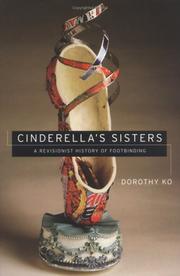| Listing 1 - 1 of 1 |
Sort by
|

ISBN: 0520218841 9780520218840 9786612360435 0520941403 9780520941403 9780520253902 0520253906 1282360434 Year: 2005 Publisher: Berkeley University of California Press
Abstract | Keywords | Export | Availability | Bookmark
 Loading...
Loading...Choose an application
- Reference Manager
- EndNote
- RefWorks (Direct export to RefWorks)
The history of footbinding is full of contradictions and unexpected turns. The practice originated in the dance culture of China's medieval court and spread to gentry families, brothels, maid's quarters, and peasant households. Conventional views of footbinding as patriarchal oppression often neglect its complex history and the incentives of the women involved. This revisionist history, elegantly written and meticulously researched, presents a fascinating new picture of the practice from its beginnings in the tenth century to its demise in the twentieth century. Neither condemning nor defending foot-binding, Dorothy Ko debunks many myths and misconceptions about its origins, development, and eventual end, exploring in the process the entanglements of male power and female desires during the practice's thousand-year history. Cinderella's Sisters argues that rather than stemming from sexual perversion, men's desire for bound feet was connected to larger concerns such as cultural nostalgia, regional rivalries, and claims of male privilege. Nor were women hapless victims, the author contends. Ko describes how women-those who could afford it-bound their own and their daughters' feet to signal their high status and self-respect. Femininity, like the binding of feet, was associated with bodily labor and domestic work, and properly bound feet and beautifully made shoes both required exquisite skills and technical knowledge passed from generation to generation. Throughout her narrative, Ko deftly wields methods of social history, literary criticism, material culture studies, and the history of the body and fashion to illustrate how a practice that began as embodied lyricism-as a way to live as the poets imagined-ended up being an exercise in excess and folly.
S11/0710 --- S11/0742 --- China: Social sciences--Women: general and before 1949 --- China: Social sciences--Footbinding --- Footbinding --- Bandage des pieds --- History --- Pathology --- Sociology of the family. Sociology of sexuality --- Human physiology --- China --- Binding of feet --- Foot --- Foot-binding --- Deformities, Artificial --- Artificial deformities --- Binding --- Abnormalities --- Social aspects. --- Feet --- Paw --- Paws --- Leg --- age of disavowal. --- beauty. --- china. --- chinese culture. --- chinese history. --- cultural nostalgia. --- dance culture. --- embodied lyricism. --- fangzu. --- fashion and clothing. --- female body. --- female desire. --- femininity. --- footbinding. --- gender expectations. --- gender performance. --- gender studies. --- high status. --- historical. --- history. --- imaginary geography. --- male desire. --- male power. --- male privilege. --- material culture studies. --- medieval court. --- men and women. --- patriarchal oppression. --- political. --- regional rivalry. --- self respect. --- social history. --- tianzu. --- Mutilations --- Images of women --- Female body --- Book
| Listing 1 - 1 of 1 |
Sort by
|

 Search
Search Feedback
Feedback About UniCat
About UniCat  Help
Help News
News